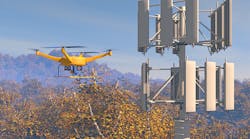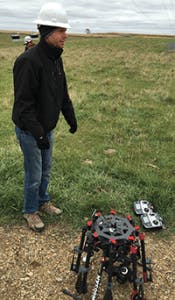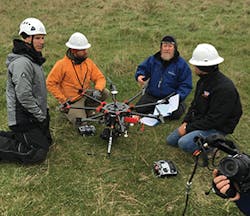Latest from 5G/6G & Fixed Wireless Access/Mobile Evolution
"As far as operating over people specifically is concerned, additional antennas are being placed on towers, utility structures, light poles, and rooftops, which means that it is essential that OMB and the FAA provide sufficient flexibility in the rules to permit work to be done in a safe and reasonable fashion over people."
The Commercial Use of UAS in the Communications Tower Industry
By Todd Schlekeway and Jim Goldwater
Like so many others, the National Association of Tower Erectors (NATE) is greatly interested in the enormous commercial potential offered by unmanned aerial systems (UAS), popularly referred to as drones. As an organization committed to safety, NATE, a non-profit trade organization in the wireless infrastructure industry, believes that the use of UAS can substantially enhance the safety of tower workers.
There are hundreds of thousands of communication and broadcast towers, some approaching 2,000 feet in height, throughout the US that should be inspected, serviced, and maintained, for the rest of their service lives. Many of the climbs involving tower inspections can be eliminated with the use of newer and better technology and techniques.
One such technique, whereby employees are hoisted to or from workstations on communication towers through a procedure known as "riding the line", is considered the safest method of ascending or descending a tower. It was the product of extended negotiations between our organization and the Occupational Safety and Health Administration within the U.S. Department of Labor.
Another is the deployment of UAS.
A drone inspects a cellular tower, one of many applications this technology has in the wireless and broadcast infrastructure industries. (Photo courtesy of Sentera)
It is undeniably true that the act of climbing up or down a tower is inherently risky, so minimizing the risk caused by climber fatigue or weather is critical. Couple that risk with significantly greater need for new or modified towers resulting from surging demands for broadband underscores the critical importance of deploying available life-saving techniques.
To its great credit, the Federal Aviation Administration (FAA) recognized the many benefits offered by UAS when in June 2016 it issued a massive regulation addressing the operation of small UAS (sUAS) in the National Airspace. This final rule permits the utilization of sUAS (less than 55 pounds) not only up to 400 feet above ground level, but higher than 400 feet if the sUAS remains within 400 feet of the structure (with some limitations, such as not over people), and within visual line-of-sight. Commercial drone pilots must be at least 16 years old, pass an aeronautical knowledge test, obtain an FAA remote pilot airman certificate, and pass a background check by the federal Transportation Safety Administration.
Federal rules also require that drones be registered, and cannot operate within 5 miles of an airport without permission from air traffic control.
FAA reauthorization legislation championed last year by Senate Commerce Committee Chairman John Thune (R-S.D.) and Sen. Maria Cantwell (D-Wash.) included extensive language on unmanned aerial systems.
It is easy to see how the use of small drones can benefit the tower industry. Instead of having a worker take hours to climb a 750-foot tower while wearing more than 50 pounds of equipment only to encounter some obstruction or, say, a bee hive, the UAS can inspect the structure in minutes. This will not only save time and mitigate risk, it can also greatly facilitate critical tower work. Accordingly, this is good for the industry, good for the nation’s economy and competitiveness, and good for the country’s critical communications needs.
NATE has created a UAS Committee, which is comprised of tower contractors, licensed pilots, and UAS service provider companies. The committee released a resource document, "UAS Operations Around Vertical Communication Infrastructure", which is intended to educate the wireless infrastructure industry and communications tower personnel about the safe use of the technology. The committee updated the guidance document following the issuance of the UAS rule by the FAA.
Brian Jensen, Project Engineer at Needmore Towers, Inc. prepares to utilize a drone to inspect a cell tower near Montrose, South Dakota.
Among the issues still under discussion deal with flying over people and visual line-of-sight. Representatives from our organization participated in meetings with the FAA, the White House Office of Information and Regulatory Affairs within the Office of Management and Budget, the National Telecommunications and Information Administration within the Department of Commerce, and congressional offices about these matters.
As far as operating over people specifically is concerned, additional antennas are being placed on towers, utility structures, light poles, and rooftops, which means that it is essential that OMB and the FAA provide sufficient flexibility in the rules to permit work to be done in a safe and reasonable fashion over people.
We also believe that since many broadcast towers range from 1,500 to 2,000 feet tall, it is important that the industry be granted flexibility to operate UAS beyond visual-line-of-sight in these instances.
After the Federal Communications Commission’s (FCC) 600 MHZ Broadcast Spectrum Incentive Auction concludes — the next step resulting from congressional legislation in 2012 authorizing the FCC to conduct an auction that would free up television frequencies and feed the demand for more wireless broadband service — there will be a significant spike in tall tower work "repacking" these tall communication towers with new antennas and performing required structural modifications and other improvements.
The wireless and broadcast infrastructure industries and their respective workforces are currently preparing for an increase in this work. Unquestionably, there are numerous safety and efficiency benefits associated with the utilization and operation of UAS technology beyond visual-line-of-sight.
Challenges and Concerns
NATE recognizes and appreciates the national focus on the commercial use of drones. However, we would be remiss if we didn’t at least note some concern with the non-commercial use.
A crew discusses their pre-flight UAS plan at the tower site.
The FAA projected that 2.5 million unmanned aerial systems were sold last year, with about a quarter of those going to commercial users. Another 4.8 million are forecast to be sold in 2017, with more than half to be used commercially. The FAA expects total sales to climb by another 5.5 million in 2018, 6.1 million in 2019, and 7 million in 2020. That means that nearly 27 million new UAS could be in the air by the end of the decade, with about 11 million of those being flown commercially.
We believe that commercial users will be considerably more aware of federal regulations and restrictions than recreational users, and remain concerned that insufficient knowledge or training could result in an accident that could have a chilling effect on the sale and deployment of UAS for commercial purposes.
The bottom line is that the proper use of unmanned aerial systems can help save lives while promoting productivity in the communications tower industry. NATE heartily endorses the safe deployment of this technology. It is unquestionably in the public good.
About the Authors
Todd Schlekeway became the Executive Director of the National Association of Tower Erectors (NATE) in June of 2012. He provides overall leadership and vision working in concert with the Association’s staff, Board of Directors, volunteer Standing Committees, and more than 750 member companies. For more information, please e-mail [email protected] or visit http://natehome.com/.
Jim Goldwater is the Senior Vice President at Bob Lawrence & Associates, Inc. He has more than 35 years of experience working with federal agencies and Congress, including almost 20 years with NATE. For more information, please email Jim at [email protected] or visit http://bl-a.com/.
Save
Save
Save
Save
Save








